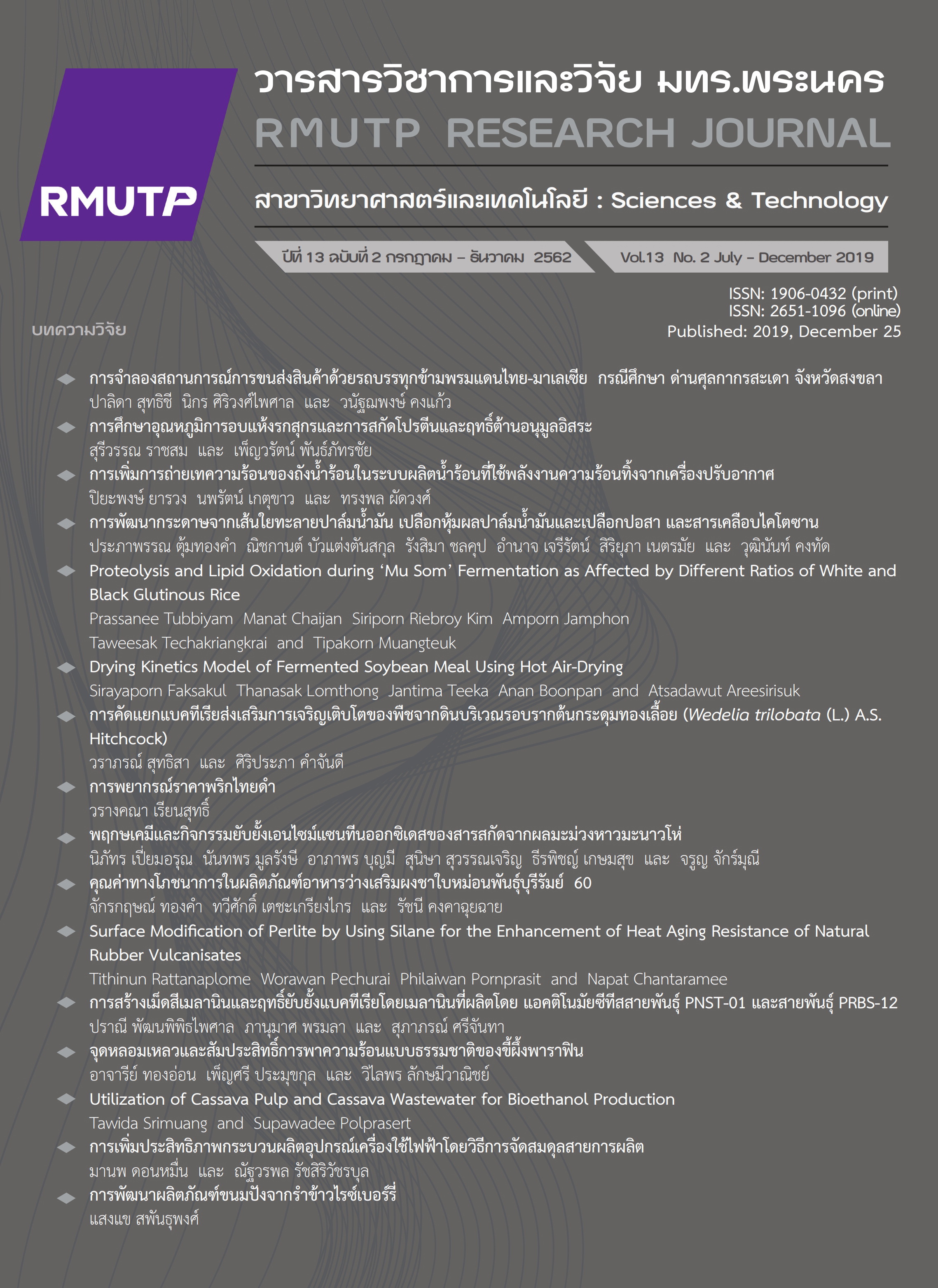Development of Bread with Riceberry Rice Bran
Main Article Content
Abstract
The objective of this research were 1) to study amount of riceberry rice bran in bread at 10, 20, 30 and 40 percent of the flour weight. Sensory evaluation revealed that the riceberry rice bran in bread with 10%, similar to the amount of riceberry rice bran 30% received the highest likability scores in terms of in the characteristic, color, odor and taste. There are differences in softness and overall of bread, on physical and chemical qualities. found that the amount of water activity (aw) of riceberry rice bran in bread in 10 to 20 percent and 40 percent bread was not significantly different (p>0.05) but The difference between the amount of riceberry rice bran in bread is 30%. The value of water activity (aw) decreases. The texture of riceberry rice bran in bread is found to be lower than the hardness (hardness) of rice bran rice bran. Baking in 10 percent and 30 percent bread is not significantly different (p≥0.05) but different with the amount of rice bran. In 40 percent bread, the hardness increased. The color of the rice bran in the 4 levels of bread was significantly different (p≤0.05). Riceberry rice bran in bread makes the brightness value reduce obesity in bread that has been recognized as having a strong flavor. 2) For the study analyze anthocyanin and shelf life of riceberry rice bran in bread, found that the total amount of microorganisms and yeast, mold stored on day 0 no microorganisms and yeast mold were found. But when collected to the 3rd day until the 6th day, the amount of microorganisms and yeasts increased. the shelf life of riceberry rice bran in bread can be stored for 3 days. The proximate analysis showed that developed riceberry rice bran bread 30% had the carbohydrate 44.72, moisture 29.14, fat 12.88, protein 12.77, fiber 0.36, ash 0.11 and anthocyanin 402.01 mg/kg.
Article Details
References
[2] P. Yuphon and P. Wiyy, “ Quality Improvement of Sandwich Bread Substituted,” The Journal of KMUTNB., Vol. 21, No.3. Sep-Dec, 2011.
[3] A. Rachan, “Sweet Bread Supplemented with Ripe Palm Fruit Pulps,” RMUTP Research Journal, Vol. 9, No. 2, September, 2015.
[4] Rice Gene Discovery Unit & Rice Science Center. (2018 February 25). Nutrition in brown rice seeds [Online]. https://dna.kps.ku.ac.th/index.php/news-articles-rice-rsc-rgdu-knowledge/rice-breeding-lab/riceberry-variety
[5] RiceberryThai. (2017, December 4). Outstanding nutritional properties of rice berry. [Online]. https://riceberrythai.blogspot.com/
[6] K. Chansom, “Stabilization of Rice Bran by Microwave.” Master of Science (Food Science), Kasetsart University, Bangkok, 2003.
[7] R.E. Wrolstad, Anthocyanins, In Natural Food Colorants, F. J. Francis and G. J. Lauro, Eds. New York: Marcel Dekker, pp. 237-252. 2000.
[8] R. Wrolstad, , R. Durst, and J. Lee, “Tracking Color and Pigment Changes in Anthocyanin Products Trends in Food” Science and Technology, 16, 423–428, 2005.
[9] AOAC, Official methods of analysis of AOAC international, 18th ed. AOAC international, 2005.
[10] N. Rao Lakkakula, M Lima., T Walker, “Rice bran stabilization and rice bran oil extraction usingohmic heating.” Bioresour. Technol. 92: 157-161, 2004.
[11] Y.R. Lee, K.S. Woo, K.J. Kim, J.R. Son, H.S. Jeong, “Antioxidant Activities of Ethanol Extracts from Germinated Specialty Rough Rice,” Food Science and Biotechnology, 16, 765–770, 2007.
[12] G.G. Bellido, and T. Beta, “Anthocyanin Composition and Oxygen Radical Scavenging Capacity (ORAC) of Milled and Pearled Purple, Black, and
Common Barley,” Journal of Agricultural and Food Chemistry, 57: 22-28, 2009.
[13] M. Hiemori, Koh, E. and Mitchell, A.E., “Influence of Cooking on Anthocyanins in Black Rice (Oryzasativa L. japonica var. SBR),” Journal of
Agricultural and Food Chemistry, 57: 1908-1914, 2009.
[14] R. Sompong,, S. Siebenhandl-Ehn, Linsberger-Martin, G. and Berghofer, G.E., “Physicochemical and Antioxidative Properties of Red and Black Rice Varieties from Thailand,” Food Chemistry, 124: 132-140, 2011.
[15] G. L. Robertson, Food packaging: principles and practice. CRC press, (2013).
[16] R. Sujitta, J. Kanokwan, W. Obcheuy, “Develpmet of Sandwich Bread Formulation Substituted Wheat Flour with Riceberry Rice Bran” Phranakhon Rajabhat Research Jounmal (Science and Technology), Vol.13, No.1, 123-138. 2018.


